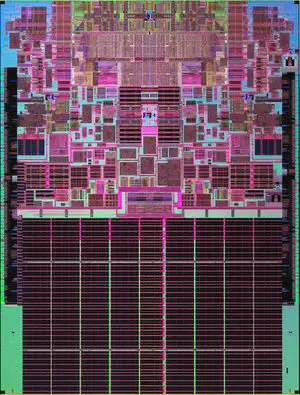From WikiChip
Difference between revisions of "intel/microarchitectures/core (client)"
m (At32Hz moved page intel/microarchitectures/core to intel/microarchitectures/core (client)) |
|||
| (One intermediate revision by one other user not shown) | |||
| Line 7: | Line 7: | ||
|introduction=April, 2006 | |introduction=April, 2006 | ||
|phase-out=May, 2009 | |phase-out=May, 2009 | ||
| − | |isa | + | |isa=x86-64 |
| − | |||
| − | |||
|process=65 nm | |process=65 nm | ||
|predecessor=Modified Pentium M | |predecessor=Modified Pentium M | ||
Latest revision as of 20:08, 9 March 2018
| Edit Values | |
| Core µarch | |
| General Info | |
| Arch Type | CPU |
| Designer | Intel |
| Manufacturer | Intel |
| Introduction | April, 2006 |
| Phase-out | May, 2009 |
| Process | 65 nm |
| Instructions | |
| ISA | x86-64 |
| Succession | |
Core was the microarchitecture for Intel's 65 nm process for desktops and servers as a successor to NetBurst. Core was replaced by the Penryn microarchitecture in late 2008.
Contents
Architecture[edit]
| This section is empty; you can help add the missing info by editing this page. |
Key changes from NetBurst[edit]
| This section is empty; you can help add the missing info by editing this page. |
Overview[edit]
When Core was introduced in 2006, Intel described it as a merger of both P6 and NetBurst. When scrutinizing the details, it's fairly clear that little was actually borrowed from NetBurst. In fact, it wasn't until Intel's entirely new microarchitecture Sandy Bridge that a true merger presented itself.
| This section requires expansion; you can help adding the missing info. |
Die Shot[edit]
Dual-core Core[edit]
- Woodcrest
- 143 mm²
- 291,000,000 transistors
- 65 nm process
- 2 cores
Documents[edit]
- Intel® Processor Micro-architecture – Core®; Intel® Software College, 2006
- White Paper: Inside Intel® Core TM Microarchitecture, 2006
- Intel Multi-core Architecture and Implementations, March 7, 2006
- Intel® Core Microarchitecture, March 8, 2006
- Intel® Core Microarchitecture, IDF
- Core, Justin Rattner Senior Fellow, Chief Technology Officer, IDF
Facts about "Core - Microarchitectures - Intel"
| codename | Core + |
| designer | Intel + |
| first launched | April 2006 + |
| full page name | intel/microarchitectures/core (client) + |
| instance of | microarchitecture + |
| instruction set architecture | x86-64 + |
| manufacturer | Intel + |
| microarchitecture type | CPU + |
| name | Core + |
| phase-out | May 2009 + |
| process | 65 nm (0.065 μm, 6.5e-5 mm) + |
